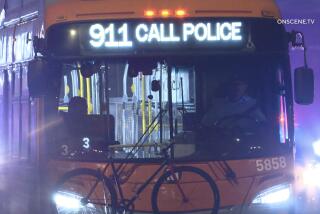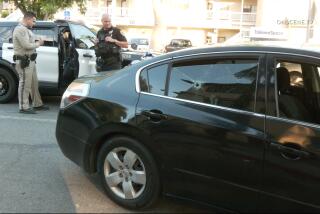Avoiding Freeways Is No Rx for Roadway Gun Assaults, Study Finds
- Share via
It may not be such a smart idea after all to steer clear of freeways in hopes of not being shot by a congestion-addled driver, according to the results of an investigation into the spate of Los Angeles freeway shootings in 1987.
Researchers at the U.S. Centers for Disease Control found that most of the roadway gun assaults that occurred between June and August, 1987, took place on surface streets, not freeways--a fact they say challenges the wisdom of altering one’s commuting patterns to avoid being shot.
“Despite the fact that the proportion of all roadway assaults is increasing on freeways, the public’s perception that such assaults can be avoided by staying off the freeways appears to be unfounded,” they wrote last week in the Journal of the American Medical Assn.
The group analyzed the highly publicized rash of gun incidents for any underlying patterns: Who tended to be involved? Was the rate really higher than in the past? Was there any link between the assaults and traffic jams?
Their findings include:
- State, county and Los Angeles law enforcement authorities received 137 reports of roadway firearm assaults between June 18 and Aug. 31. Thirty-nine percent were brandishings and 61% were shootings. Twenty percent of the shootings resulted in injuries. Two were fatal.
- The assaults occurred on all types of roadways: 63% on surface streets, 36% on freeways and less than 1% on highways. More than a third of the victims reported having had some sort of contretemps with the suspect over such things as tailgating, merging and lane-changing.
- The apparent increase in roadway gun assaults that summer was in fact real: There were just 32 during a comparable period in 1985 and 91 in 1986. So-called freeway-only firearm assaults were four in 1985, 15 in 1986 and 49 in 1987.
- There appeared to be some connection between freeway congestion and assaults: The most heavily traveled freeways had the highest assault rate. However, more than two-thirds of the assaults occurred outside rush hour.
“Despite the enormous national and local concern about these incidents, the number of injuries and deaths from roadway firearm assaults was relatively small,” the researchers observed. “Because more than 1,000 homicides and 40,000 aggravated assaults are committed in Los Angeles County each year, roadway assaults do not constitute a large proportion of the problem of interpersonal violence.”
More to Read
Sign up for Essential California
The most important California stories and recommendations in your inbox every morning.
You may occasionally receive promotional content from the Los Angeles Times.










